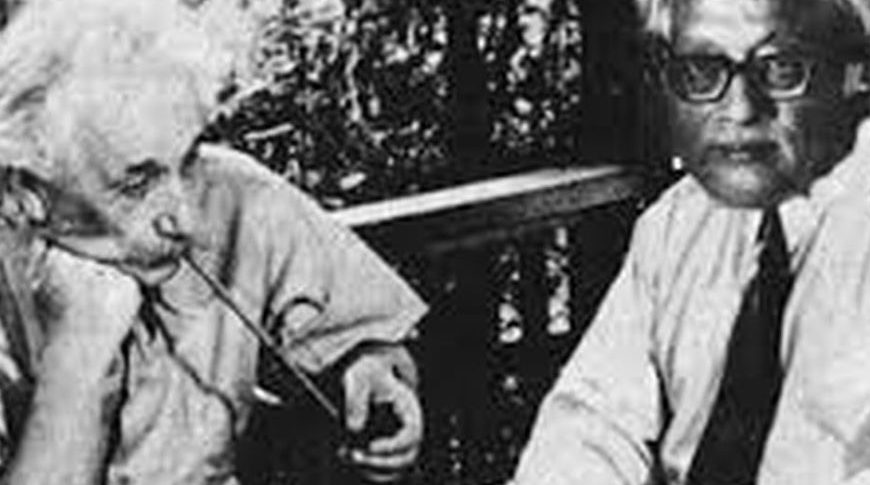By Shamin Chowdhury






Looking into whatever resources I could find of Satyendranath Bose online, I was somewhat disappointed. It seems that many of the articles people have written are biographical in nature or only talk informatively about the accomplishments of the man himself. While these are important and I encourage anyone to read up on Satyendranath Bose and his contributions to quantum statistical mechanics (and the boson which was named after him!), I was hoping to find more. It is easy enough to find out about a person’s accolades and biography from a quick Google search, at least in our day and age. But let’s move away from our day and age for a second. Let’s go back to when people communicated with handwritten letters and had to wait weeks, maybe even longer, for messages to be delivered. It is in letters like these written to and from Bose stored in the S.N. Bose National Centre for Basic Sciences online archives that I found perspectives and emotions of Satyendranath Bose that I did not expect.


You might wonder how learning more about Satyendranath Bose as an individual could be relevant compared to his discoveries. After all, these are what make him famous. However, especially for someone like myself who is studying physics and hopes to follow a similar path as Satyendranath Bose in becoming a theoretical physicist, learning about his thoughts and feelings are very helpful in getting an idea of his mindset towards his interests, and this informs me of how I should consider approaching my own interests. With that said, I will now proceed to analyze a few of his letters in hopes of learning more about the individual named Satyendranath Bose.

The first letter I’d like to analyze is one you may have heard of if you are at all familiar with how Bose ended up cooperating with Einstein[1]. Bose wrote this letter to Einstein June 4, 1924 after he had done work examining Planck’s Law and the proportionalities involved in it (which are important because these can be experimentally measured to confirm the theory!). I’d like to note that Bose’s cursive is somewhat difficult to read, so I apologize if I have made any mistakes in doing so. Anyways, Bose addresses Einstein in his letter “[…] (I have tried to deduce the coefficient […] in Planck’s Law independent of the classical electrodynamics,) […] I do not know sufficient German to translate the paper. If you think the paper worth publication, I shall be grateful if you arrange for its publication in Zeitschrift für Physik […]” Here, we can tell that on the surface that Bose’s goal was to have his theories reviewed by Einstein and published in an, at the time, relevant scientific journal in Germany if Einstein found them to be correct and worth publishing. Bose addresses in a rather respectful manner, saying “[…] If you think the paper worth publication, […]” and “[…] I shall be grateful if you arrange for its publication […]” This can be seen on the one hand as an apparent and expected formality.
However, Einstein at this time is well renowned for his theories of relativity. Bose looks up to Einstein, and his admiration is such that Bose brings up even the slightest connection he had with Einstein when he writes “I do not know whether you still remember that somebody from Calcutta asked your permission to translate your papers on Relativity in English. You acceded to the requests, the book has since been published. I was the one who translated your paper on Generalized Relativity.” This is how he finishes the letter before he signs at the end. The manner of idolization that Bose presents here is something many of us can relate to. Many of us can recognize times when we wanted to be noticed or acknowledged by others, and that is exactly what Bose is doing here when he ends his letter with this memory of his.

One could also posit that Bose is writing this to make Einstein aware of his capabilities and interest in having translated his paper on general relativity, but I doubt this because it seems more to be the case that Bose was expressing himself as earnestly as he could. This would also parallel the respect and admiration he showed earlier in the letter. One could perhaps even argue that Bose’s greater goal was to receive recognition from the man he idolized so much, maybe even more than he wanted his paper to be published in Germany. I’d like to examine a letter from Einstein to Bose. This is not a response to the above letter[2]; however, after having presented Bose’s regard for Einstein, it would be rather fitting to then present the disposition, a rather positive one might I add, of Einstein towards Bose.
This letter from Einstein is dated October 4, 1952, so within a few decades after Bose’s above letter. It then serves to note that this view of Einstein is likely one developed over a similar amount of time. Nevertheless, it is pleasant to find that Bose received the recognition he sought, for Einstein writes “Thank you for your letter of September 20th. I am glad to see that you are interested in this theory and that you have devoted so much work and penetration […] I am now firmly convinced that the equation-system represents the only formally natural generalization of the relativistic law of gravitation.” For Einstein to have said that he was then “firmly convinced” is quite remarkable. The kind of scrutiny that Einstein, and really all respectable scientists have, is truly intense, so for Einstein to have said that he was “firmly convinced” says a great deal of the outstanding work and effort that Bose undertook

(1894-1974)